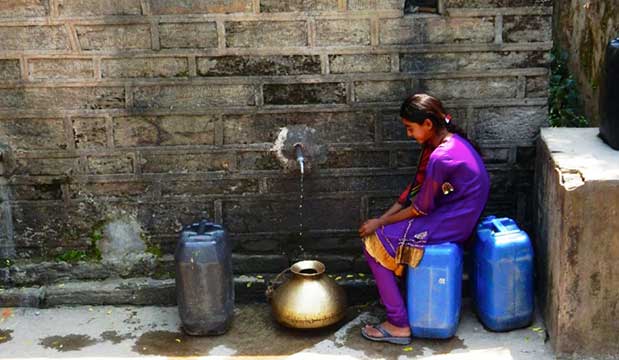By Harriet Larrington-Spencer, ICIMOD
Pyukhari: A mid-hills research site
Pyukhari is a small village perched in the mid-hills of the Upper Ganga River basin 14 kilometres from Devprayag, the confluence point of the Alaknanda and the Bhagirathi Rivers, which merge to form the Ganga. Although not inaccessible, access to the village takes time as the roads are narrow, with steep drops and, particularly during the monsoon, vulnerable to damage by landslides. The final ascent to the village must be made on foot. The dry, brown landscape of shrubs and terraces surrounding Pyukhari (photo 1) strongly contrasted with the much greener landscapes that I observed in the plain and high-altitude areas of the river basin (photo 2).


Photo 1 (left): Scrub and terraces in the mid-altitudes of the Upper Ganga River basin. Photo 2 (right): Forests in the high-altitudes.
Rajani (photo 3) has been living in Pyukhari since her marriage. Her husband, alongside many other men from the village, migrates to work in the tourism industry, whilst she, like many other women, is responsible for the production activities on the household’s agricultural land. Agriculture largely consists of wheat, soybean and rice production, with the latter being grown during the monsoon season.
 Photo 3: Rajani (second from right) with her sisters and niece.
Photo 3: Rajani (second from right) with her sisters and niece.
The greatest challenge: water scarcity
When speaking with Rajani, we asked her the greatest challenge that she faced with regards to life and livelihood in Pyukhari. She immediately answered, “Water scarcity”. When asked to elaborate, Rajani explained that there were three sources of scarcity.
The first is the outcome of changing precipitation patterns in the region. Rainfall patterns are becoming much more variable, with more intense rainfall at some points in time and no rainfall at others. In addition, changes in the timings of rainfall means that rain does not arrive when it used to be previously expected.
The second source of scarcity is the result of the village water-supply system. Water is lifted from the river in the valley and then delivered via a gravity system to different villages within the hills. Water should be supplied once every three days; however, the system is very unreliable and water often does not arrive. This information was corroborated by The Energy and Resources Institute (TERI) field-office employees, who live in the neighbouring village. They also explained that the original water-supply system was constructed to provide water to around 75 villages. However, its provision has now been extended to 300 villages, despite the system’s capacity remaining the same.
The third source of scarcity is the loss of natural springs. Whilst in the past water could be collected from the springs, most of them have now dried up. Rajani attributed this to overuse, climatic changes and infrastructural development. Although some streams are revived during the monsoon season, they are no longer a reliable source of water.
Whilst the first identified cause of scarcity impacts upon agricultural production, the other two impact upon water availability for household purposes and livestock rearing. The irony of increasing water scarcity, despite the village being located within the Upper Ganga river basin, was not lost on Rajani and her sisters. “Puri nadiya yahin se jati hain, par hum pyaase hain,” they said. “All the rivers flow through our land and yet we are thirsty.”
The impact of scarcity
On days when water does not arrive in the village tap (photo 4), Rajani and other women from the village must descend to the road and make use of a public water pump. Here they can fill containers with water, which they must then carry themselves up to the village. One container holds around three litres of water and women carry multiple containers in one trip. Rajani estimated that around ten trips are required in one day to fulfil household and livestock water requirements. From my own estimations at walking the route, a round trip is likely to take between 20 to 30 minutes, depending upon how close to the village entrance the women live.
 Photo 4: A girl waits at the village tap.
Photo 4: A girl waits at the village tap.
As water scarcity increases, Rajani’s time devoted to the collection of water also increases. This increasing workload for her does not happen in isolation, but rather in addition to the daily activities she is already undertaking. These include collecting fuel and fodder from the forest every day from around 7 am till 1 pm, undertaking agricultural activities and looking after all household activities, including cooking, cleaning and childcare.
Households within Pyukhari have started to make adaptations to the increasing water scarcity. They have, for instance, started using concrete or plastic storage tanks to harvest rainfall during the monsoon, which then lasts a few months to provide the household with water. Another is male outmigration: although outmigration cannot be attributed to the water scarcity alone, it can be perceived as part of a livelihood-diversification strategy to do with their living in an environment in which it is becoming increasingly difficult to subsist.
This outmigration results in a day-to-day reality for women in Pyukhari wherein their workload increases as water becomes scarcer. As women’s time dedicated to the collection of water increases, time that could be dedicated to other activities, such as health care, education and involvement in social groups, is reduced. Considering that these activities can be empowering for women, the growing water scarcity could have significant implications in terms of equality between men and women in Pyukhari.
